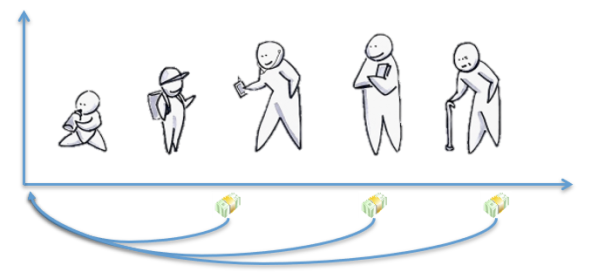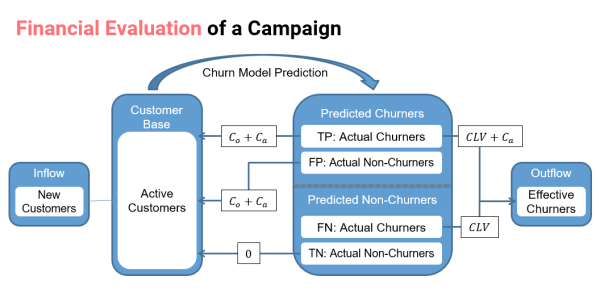By Alejandro Correa and Maria Fernanda Cortes This post is part of a series in which I’m discussing several parts of my AI_at_Rappi presentation. In a previous post I discussed a particular algorithm for recommending restaurants called rest2vec, In a follow-up, I discussed how to include financial costs when analyzing a churn model. This time... Continue Reading →
Maximizing a churn campaign’s profitability with cost-sensitive Machine Learning, part 3
This post is part of a series in which I'm discussing several parts of my AI_at_Rappi presentation. In the last two posts, we first discussed how to evaluate a churn marketing campaign using a financial evaluation measure and then how to estimate the customer lifetime value and also how it is possible to design experiments... Continue Reading →
Maximizing a churn campaign’s profitability with cost-sensitive Machine Learning, part 2
This post is part of a series in which I'm discussing several parts of my AI_at_Rappi presentation. In the latest post, we discussed how to evaluate a churn marketing campaign using a financial evaluation measure. In this one, we're going to deep down in a couple of important concepts needed to fully being able to... Continue Reading →
Maximizing a churn campaign’s profitability with cost-sensitive Machine Learning, part 1.
This post is part of a series in which I'm discussing several parts of my AI_at_Rappi presentation. In a previous post I discussed a particular algorithm for recommending restaurants called rest2vec. This time I wanted to talk about how to model customer churn using cost-sensitive machine learning. Churn modeling The two main objectives of subscription-based... Continue Reading →
Rest2Vec: Recommending similar restaurants
It has been almost a year since I joined the Rappi Artificial Intelligence team. It has been a blast, lots of highly complex challenges with big rewards. As part of my role, I have been giving talks on countless occasions, and even if I have to adjust my speech according to each audience background, I... Continue Reading →
Hunting Malicious Certificates with Deep Learning
Seeing the signature green padlock and “https” in the browser bar means one thing for most internet users: safety. However, is this sense of security justified? The short answer is a loud, resounding, no! To start, let’s define what “https” really means: that the website being accessed is encrypted, and all information sent through the site is protected by... Continue Reading →
Machine Learning Algorithms Explained – Support Vector Machines
SVMs are some of the most important and widely used algorithms available today. They’re used for supervised classification problems. As a reminder, supervised learning refers to algorithms that learn from training data comprised of both input vectors and expected output data. Classification is used to describe a dataset that the algorithm must separate into predicted... Continue Reading →
How to download Kaggle data into Google Colab
Colab is this awesome initiative from google research that allows anyone to play with Nvidia Telsa K80 for free. I was always struggling on how to show the potential of deep learning to my students without using GPU's. Then everything changed when I discovered colab. To get started in colab (I will write a more... Continue Reading →
Machine Learning Algorithms Explained – Logistic Regression
Logistic regression is a supervised statistical model that predicts outcomes using categorical, dependent variables. Categorical variables take on values that are names or labels, such as: win/lose, healthy/sick or pass/fail. The model can also be used on dependent variables with more than two categories, in which case it is called multinomial logistic regression. Logistic regression... Continue Reading →
DeepPhish: Simulating malicious AI
Recently we presented a research paper on the malicious usage of AI by cyber attackers. Here the abstract, slides a link to the paper. Machine Learning and Artificial Intelligence have become essential to any effective cyber security and defense strategy against unknown attacks. In the battle against cybercriminals, AI-enhanced detection systems are markedly more accurate... Continue Reading →
AI vs AI – Can Predictive Models Stop the Tide of Hacker AI?
Long ago, the introduction of the internet moved crime from physical to digital locations, where anti-fraud actors play a high-stakes game of detection and prevention, always working to stay one step ahead of fraudsters. The battles of modern-day cybercrime follow the same pattern, with one major difference – cybercriminals are far more sophisticated than they... Continue Reading →
Machine Learning Algorithms – Naive Bayes Classifier
A Naive Bayes Classifier is a supervised machine-learning algorithm that uses the Bayes’ Theorem, which assumes that features are statistically independent. The theorem relies on the naive assumption that input variables are independent of each other, i.e. there is no way to know anything about other variables when given an additional variable. Regardless of this assumption, it... Continue Reading →











